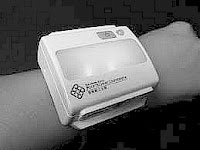Unilateral neglect is a phenomenon where the survivor does not/ cannot attend to the "bad" (affected) side. Here is a visual explanation...
If a survivor with unilateral neglect is asked to bisect a line at the midpoint they'll do this:
If a survivor with unilateral neglect is asked to
If a survivor with unilateral neglect is asked to fill in the numbers on a clock face they'll do this:
Here I'll discuss two options for, hopefully, decreasing unilateral neglect. And decreasing it is important: If the arm is not payed attention to, the survivor will not use it. And you know the brain... its very use it or lose it.
The 2 options: Limb activation, and taping. These are not the only options. For more options go here and search for the word unilateral.
The 2 options: Limb activation, and taping. These are not the only options. For more options go here and search for the word unilateral.
Limb activation.
Typically, clinical studies of this treatment have used a "Limb Activation Device."
Typically, clinical studies of this treatment have used a "Limb Activation Device."

These machines cue the survivor to pay attention by buzzing, making a sound, or lighting up. So, there's the problem: You need a machine. You could buy a watch that vibrates and set it for every minute or so. When it vibrates the survivor knows to do a movement with that arm. This is different from most treatments for unilateral neglect. Usually, the survivor is told to attend to the affected side (turn their head, and find their affected side). But that is the head finding the arm. With vibration, the arm reminds the head.
Or you could just touch the survivor's affected side at a set interval, and the survivor then moves that limb.
There is quite a bit of research that limb activation works.
Taping
This is one I got from a therapist at one of my seminars. Although its much less evidenced based, its much simpler, and worth a try.
The survivors neck is taped with Kinesio Tape (also known as KT Tape or TheraTape).
You know the stuff, athletes wear colorful tape on their body and its supposed to reduce pain, or increase performance. Many of these claims are questionable.
In a survivor with unilateral neglect the tape would be used to provide a pull towards the affected side. The tape is stretchy, so if the survivor turns towards the "good" side, they would be reminded by the feeling of stretch to turn towards the "bad" side. This would be the approximate line of tape (and line of pull).
Clever, huh?
Therapists are clever.
Boring stats
795,000 Americans have a stroke per year and unilateral neglect occurs in approximately 30% of individuals who experience a CVA. Left unilateral neglect is more prevalent, affecting 40-50% of left hemis.
Defined as a failure to report, respond, or orient to sensory stimuli presented to the side contralateral to the stroke lesion. Unilateral neglect (UN) is found in about 23% of stroke patients. • More common in patients with Right sided lesions (42%) than Left sided lesions (8%) and is more persistent with Right sided strokes. • Recovery of UN common; most recovery occurs in 1st 6 months and later recovery is less common. • UN associated with negative prognosis for functional outcome, poorer mobility, longer LOS in rehab, and slower rates of improvement; tend to be more functionally disabled at discharge.
Defined as a failure to report, respond, or orient to sensory stimuli presented to the side contralateral to the stroke lesion. Unilateral neglect (UN) is found in about 23% of stroke patients. • More common in patients with Right sided lesions (42%) than Left sided lesions (8%) and is more persistent with Right sided strokes. • Recovery of UN common; most recovery occurs in 1st 6 months and later recovery is less common. • UN associated with negative prognosis for functional outcome, poorer mobility, longer LOS in rehab, and slower rates of improvement; tend to be more functionally disabled at discharge.







No comments:
Post a Comment